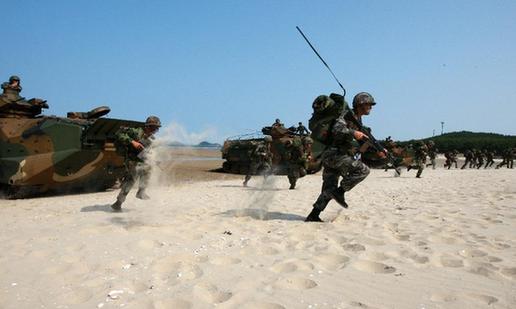US-Japan-ROK drills aim to fix alliance weakness
 0 Comment(s)
0 Comment(s) Print
Print E-mail People's Daily, June 27, 2012
E-mail People's Daily, June 27, 2012
|
|
|
South Korean marine corps take part in the Marine Corps-Navy joint military exercise at Anmyeondo beach in Chungcheong province of South Korea, June 25, 2012. [Xinhua] |
Recently, the temporary tranquility in the Korean Peninsula was once again interrupted by the uproar of a series of military exercises. From June 21 to 22, the navy of the United States, Japan, and South Korea jointly held military exercises in waters to the south of the Korean Peninsula. From June 23 to 25, the United States and South Korea met again for military exercises in the Yellow Sea. Of these, the military exercise of the three countries is the first successful "matchmaking" by the United States for the joint participation of its two allies.
The United States has troops stationed in both Japan and South Korea, which are two big military allies of the United States in Northeast Asia. However, the military relations between Japan and South Korea had been quite "cold", mainly because of the anti-Japanese public opinion in South Korea. Since South Korea had been subjected to long-term Japanese colonial rule, added by the island territorial disputes between the two, the South Korean people have a strong distrust of Japan and are especially wary of the Japanese military.
But then the United States wishes to "reconfigure the Asia-Pacific layout" and borrow as much "leverage" as possible from its allies. The United States and Japan were always trying to hook in South Korea to compensate for the "short board" of Japan-South Korea military alliance and establish a military "iron triangle". Meanwhile, the situation on the Korean Peninsula has become tense again since a series of conflicts including the "Cheonan Warship" incident in March 2010.
Gong Keyu, researcher at Shanghai Institute of International Studies said that in the new round of tensions on the peninsula after North Korea launched a satellite in April this year, the South Korean government has the idea to make a tough response to such "provocation." The United States takes such opportunity to once again promote their "equilateral triangular" cooperation, resulting in the "unprecedented" military exercise.
It should be noted that each of the three countries has its own intention despite standing on the same military exercise "stage". At the beginning of the second decade of the 21st century, the United States ends the war on terrorism and starts to devote more resources toward the Asia-Pacific region, represents a significant variable in international relations in the region. Under the residual influence of the economic crisis and due to the lack of strength, the United States has adopted the "United States plus X" mode by gathering Japan, South Korea, Australia, the Philippines and other allies through strategic dialogue, military exercises and a variety of ways so as to establish an intersectional, multi-level, new type of military alliance and maintain hegemony in the Asia-Pacific region.
In regard of the recent series of military exercises, the United States stresses that the North Korean military forces threaten regional stability and seems to regard North Korea as the "imaginary enemy." But the discerning can easily see that mere North Korean would not be worthy for the two major military powers to shovel. To a certain extent, their actual "ulterior" intention is to curb the other regional powers. However, South Korea's participation in the military exercises still mainly aims to take advantage of the power of the United States and Japan to guard against and deter North Korea. After reluctantly tying itself to the U.S.-Japan "chariot", whether South Korea can get off easily is quite another question.







Go to Forum >>0 Comment(s)